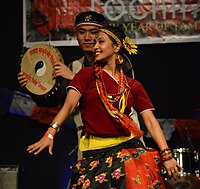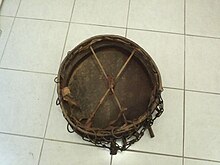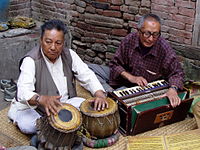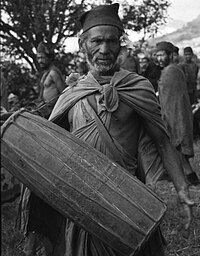
A | B | C | D | E | F | G | H | CH | I | J | K | L | M | N | O | P | Q | R | S | T | U | V | W | X | Y | Z | 0 | 1 | 2 | 3 | 4 | 5 | 6 | 7 | 8 | 9
This article needs additional citations for verification. (November 2020) |

This list contains "traditional" musical instruments used in Nepal. Instruments overlap with nearby countries, including India and Tibet. An example is the Sarangi, a common bow Indian instrument. Although the Nepali people have their own local variant Sarangi (Nepal), both instruments are known in Nepal. Some of the instrument are madal,[1] maddlam, dholak. In such cases where instruments were imported in ancient times, or when both varieties are played in Nepal, both can be included on the list. New instruments of Nepali origin may be included, as well as modern recreations of " extinct " instruments. Modern imports such as the western guitar are not included.

There are hundreds of Nepali musical instruments and they are not standardized. When considering seemingly identical instruments, the languages, region of origin, musician's ethnicity and local traditions may affect the instrument's identity and how it is played.
Research avenues

Many Nepali folk instruments [2] or lokabaja (नेपाली लोकबाजा) date back into prehistory or inaccessible history. General histories of musical instruments, such as History of Musical Instruments by Kurt Sachs, have little to say directly about Nepal. Sachs focused two chapters on India, and when addressing the ranasrnga, on Northern India. When instruments used in Nepal were included in Sachs' book, such as drums with hooked sticks (p. 157), the dameru (p. 159), the lute with a barb on its sides (160–161), the sarangi (226), and the ranasrnga (p. 228), the organizational focus was on India, or "North India."
JSTORE, an online repository of academic journals has articles. An example by Thomas O. Ballinger and Purna Harsha Bajracharya, Nepalese Musical Instruments, Southwestern Journal of Anthropology, Published by: The University of Chicago Press, Vol. 16, No. 4 (Winter, 1960), pp. 398–416 (19 pages). Thomas compares the instruments he found with that found in books by A. Campbell and Daniel Wright. Gives descriptions of instruments.
- History of Nepal, by Daniel Wright, Cambridge: University Press, 1877.
- Notes on the Musical Instruments and Agricultural and Other Instruments of the Nepalese, by A. Campbell, Journal of the Asiatic Society of Bengal, Vol. 6 (1837), pp. 953-963.
The Grove Dictionary of Musical Instruments is a more comprehensive resource, with many instruments having been documented by ethnomusicologists. Random entries for Nepali instruments include Arbajo, Damaha, the Kingdom of Nepal and the ghanta (both large "male" bells and smaller "female" handbells). This resource requires either a subscription (not inexpensive), access to a university library, or purchase of the $995 set of books.[3]
The Garland Encyclopedia of World Music, Volume 5: South Asia, the Indian subcontinent does address Nepal directly in a chapter.[4]
Museum and museum catalogs: In 1995, a local project was begun in Nepal, to document the folk instruments there. Ram Prasad Kadel began to visit different parts of his country and collect examples of instruments that he found. He talked to musicians and made recordings. In 1997, he founded the Nepali Folk Instruments Museum, which opened to the public in 2002 in Kathmandu. Kadel wrote two books, catalogues of some of the museum's instruments. Nepali Lokbaja or Folk Musical Instruments of Nepal was published in 2004. The Nepali-language book contains entries and images for 375 instruments. The language made the contents inaccessible to most readers outside Nepal. In 2007 Kadel's Musical Instruments of Nepal was published, an English-language book with 362 Nepali instruments and more detailed pictures. The book is the only book in the English language whose focus is Nepali folk musical instruments. Today his museum has more than 40,000 hours of recordings.
Membranophones
Tambourines and frame drums
| Name in English | Name in Nepali | Description | Ethnic Connections | Town / Region | Picture |
|---|---|---|---|---|---|
| Daanf | डाँफ | Frame drum 28 centimeters diameter, covered with goathide held in place by bamboo lathes piercing skin and hoop across to the other side of the hoop, decorated with peacock feathers on top.[5] | Tharu | Chitwan District |  |
| Daha | tambourine.[6] | ||||
| Dambaa or damphu | डम्बा [ne] or डम्फु | Variety of damphu. Frame drum made of Koirala wood and Himalayan goral hide on one side held in place by 32 bamboo lathes. 45 cm diameter. May be decorated by the carving of a Himalayan monal bird on top.[5][7]  |
Tamang |  | |
| Damphu | (डम्फू [ne]) | Drum, similar to large tambourine. | Tamang people |  | |
| Dafa | frame drum, tambourine sized.[8] Used in Bansuri Bajan or Khin Bajan.[6] | ||||
| Hring | हृङ | Frame drum, with single goatskin head, 45 centimeters diameter, religious (Tantric Buddhist) symbols hanging on a chain.[5] Originally used by Chepang people living in the mountains of Mahabharata mountain range, used for jharphuk (healing ritual) and tantra mantra.[9][10]  |
Chepang people | Dhading District, Makwanpur District, Chitwan District |  |
| Dhyāngro | ढ्याङ्ग्रो [ne] | a single headed or double headed frame drum, may have a handle; used by jhakri (shamans) and Buddhist musicians.[11][12] | *Magars, Kirati, Tamang, jhakri (shamans), Tibetan Buddhist musicians |  | |
| Jhyaali Khainjadi | Khaijadi tambourine with mujura (मुजुरा) cymbals.[8] An instrument may have as many as four holes in its sides, which the mujura cymbals are fastened, so that they jingle as the instrument is being played.  |
 | |||
| Khaijadi or Kanjira or Khañjari | खैंजडी [ne] | A leather-covered tambourine covered on only one side, used in Nepali society since ancient times. 7-9 inches diameter x 2-4 inches deep. Deer or goat skin. The khanjadi is slightly smaller than the damphu. Traditionally used to accompany hymns and religious dance by Brahmin cast. |
Chhetri-Brahmin society, Magar, Gurung | Midwestern Nepal |  |
Kettle drums and single-headed drums
| Name in English | Name in Nepali | Description | Ethnic Connections | Town / Region | Picture |
|---|---|---|---|---|---|
| Dibya nagara or Dam nagara | दिव्य नगरा | Very large, copper, unpitched kettle drum (190 centimeter diameter), topped with cowhide and beaten with sticks. All but gone; two pairs remain at the Durbar Squares in Kathmandu and Bhaktapur. Played during ceremonies to Degu Teleju Bhahani, patron goddess of Newar people.[14] Name of the Damai comes from association with this instrument.[15] | Newar people |  | |
| Damaha | दमाहा | Copper kettle drum, about 30 centimeters tall x 38 centimeters diameter, topped with cowhide, beaten with a single large stick. Part of the panche baja ensemble.[16][8][17] Large: thulo damaha (ठूलो दमाह).[18] Slightly smaller and less loud, used in supportive role: sauntal (बाउँताल).[19] Small: sano damaha (सानो दमाहा).[18]
 |
Damai |  | |
| Dugdugi | Pair of single-sided goatskin drums tied together, about 18 cm and 12 cm across, played barehanded. Carried at the waist.[8] Accompany "enthusiastic" folk dances. Played by young men while dancing for young women.[20] Not the same as the dugdugi of Bangladesh, which is an hourglass drum. | Tharu people | |||
| Koncha-Khin, | कोचा खिं | Single headed drum, about 33-45 centimeters high, 18-22 centimeters diameter at head. Drum gets wider from head for about 3/4 of its length, then slopes inward. Base has air hole. Skin head tensioned by stings running from head to base and back. Head has black tuning paste. Hangs on left shoulder at waist, played with right hand (no stick). Accompanied by wind instruments.[14] Mainly played in marriage processions and accompanied with baboocha, Tah and Baya or Muhali."[21] | Jyapu | ||
| Tabala[22] | तबला [ne] | Two small drums of slightly different sizes and shapes, played as a pair. |  | ||
| Tyampko | ट्याम्को [ne] | A small Nepali kettle drum, a prominent member of the panche baja ensemble. The body of the instrument is made of soft wood, clay, copper or iron; the skin is cowhide. It is about 15cm in diameter and 15cm high, but this can vary as instruments are not standardized. It is carried on a strap around the neck, at the waist when standing, and played with two sticks.[8][14][15][23] | Damai | Western Nepal |  |
| Nagara, Naqareh | नगरा [ne] | Copper kettle drums, 45-65cm diameter. Old instrument ,formerly player at "victory ceremonies." One remaining use is to celebrate Dashain (दशैं [ne]), at the Dashain Mela festival.[24] | Gajul, Rolpa District |  |
Hourglass drums
| Name in English | Name in Nepali | Description | Ethnic Connections | Town / Region | Picture |
|---|---|---|---|---|---|
| Damaru | डमरू [ne] | Also called KantanDabDab. Small hourglass drum with bead strikers.[8] |  | ||
| Hudko | हुड्को [ne] | It is found as much in northern India as in Nepal, a two headed drum made from wood and copper is 30 cm long body x 20 cm diameter at drumheads, with a narrow waist.[14] It is hollowed out on the lathe; metal sometimes replaces wood. The tightened part houses a small hole allowing the "breathing" of the instrument. The goatskin membranes are attached to rings laced with a cord providing variable tension.[20] It is worn over the shoulder and held in the left hand, which grips the instrument at the central part while varying the tension and therefore the pitch of the sound; the right strikes the head with a bare hand. Accompanies folk dances but also jâgar shamanic rituals.[20] | Damai[25] | Western Nepal |  |
Long two-headed drums
| Name in English | Name in Nepali | Description | Ethnic Connections | Town / Region | Picture |
|---|---|---|---|---|---|
| Chyabrung or Ke | च्याब्रुङ [ne] | Wooden drum, the ends covered with cowhide, 100 cm long x 45 cm diameter. Has stick mounted internally (and wooden rings attached to stick) to vibrate and wrattle while dum is played. One drumhead odd player with the bare hand, the other with a stick.[26] | Rai, Limbu | Ilam |  |
| Dhaa or Dhah | धाः [ne] | Two headed drum, (38 centimeters x 20 centimeters), one head played with hand, the other with tuning paste on inside played with a stick. Used in festivals in Gulan near temples. Plays in Dapha bhajana Khala.[26][21] |  | ||
| Dhimay or Aelapohn dhime | धिमय् [ne] | Large (20"x16", 60 cm x 30 cm) two-headed drum, heads made from goathide, can be carried while playing.[6] One side played with a stick. The other side (with tuning paste on the inside) is hand-drummed. | Jyapu farmers | Kathmandu Valley |  |
| Ma Dhimay | मा धिमे | A larger dhimay.[6] Double headed drum, 80 centimeters long x 50 centimeters diameter, Uttis log hollowed out, heads covered with goatskin, one side has tuning paste on inside and played with hand, other side played with stick. | Jyapu | Kathmandu Valley |  |
| Dhahcha Dhimay or Yalaypoh Dhimay | Both smaller than dhimay.[6] | ||||
| Dholak | ढोलक [ne] | Two-headed wooden drum with cowhide drumheads, about 40 cm long x 20 cm diameter. Extra thick hide on one end, to be beaten with a stick. Other side is played with the bare hand. Accompanied by muhali.[8][26] | Kapali | Lalitpur in the Kathmandu Valley |  |
| Dholaki | ढोलकी [ne] | Drum, about 40 centimeters long x 20 centimeters diameter, made of Daar wood, right side covered with cowhide, left with goathide. Used in Panchai Baajaa as main rhythm instrument in Bagmati Zone and Gandaki Zone. Right side beat with stick and with fingers, left side used only the hand to beat.[26][27] | Bagmati Zone, Gandaki Zone |  | |
| Name in English | Name in Nepali | Description | Ethnic Connections | Town / Region | Picture |
| Khin | Two-headed drum with different diameter heads, tuned with paste. | ||||
| Magah Khin | Same as madal. Two membrane drum tuned with tuning paste.[6] Was specific to magar community, but "has become an important part in Newar folk music."[21] | Magar |  | ||
| Naya-Khin | नाय खिं or नाय्खि [ne] | A two-headed drum like dhah or dhimay, about 14" long x 7" diameter, used in rituals, known as 'Seeh Bajan' (funeral drum), to proclaim news in ancient times ("In the Malla period"). "Mainly played by the Khadgis."[6][21][28] | Kadgis |  | |
| Pasta-Khin or Kwatah Khin | पस्ता खिं | Term is used when Dapha Khin and Naya Khin play together...Pastah Khin is accompanied with Ponga and Tah.[21] | |||
| Yaaka khin | Double-headed drum made of soft wood, 75 centimeters long, the drumheads covered in cowhide, both heads have tuning paste.. Drum is hung around the neck, down to the waist; hand-drummed. Played at festivals, accompanies songs and hymns. Other names: can be called Dapa khin when "played in Dapa Bhajans (traditional hymns)...a single Khin is called Yakah Khin and two Khins are called as 'Joh Khin'."[21] | Newar people | Kathmandu Valley |  | |
| Madal or maadal | मादल [ne] | Two-headed drum, one head larger. Smaller than dholak. Tuning pâté on both heads.[8][6] |  | ||
| Pakhawaaja | पखावज | Double-headed wood drum, curved sides, wider in the middle, the ends covered with ox hide. About 80 centimeters long. Is tuned with spots of tuning paste on the drum heads; also tuned by adusting tuning pegs/spools.[26] Possibly related to the Indian Pakhavaj. | Newar people | Kathmandu Valley |  |
| Unidentified drum of Raute people | Raute | Machaina village, Jajarkot District |  |
Multiple heads nested
- Tri Taal, block with nested drum-heads[8]
Idiophones
Bells
| Name in English | Name in Nepali | Description | Ethnic Connections | Town / Region | Picture |
|---|---|---|---|---|---|
| Ghanta or Gan | घण्टी [ne] | Ceremonial bells.[29] Hindu temples generally have one metal bell hanging at the entrance and devotees ring the bell while entering the temple. |  | ||
| Dibya Ghanta (divine bell) | दिव्य घण्ट | Very large bells were made for the three Newar kingdoms. The dibya ghantas each hung from a wooden crossbeam by very thick chains. They were located in Kathmandu Durbar Square (big enough that 16 men could fit inside), Bhaktapur Durbar Square (holds 8 men), and Patan Durbar Square, Lalipur (holds 12 men). The dibya ghantas were used during evenings in prayer to Degu Teleju Bhadani, the patron goddess of the Newar people of Nepal.[16][30] | Zdroj:https://en.wikipedia.org?pojem=List_of_Nepali_musical_instruments
